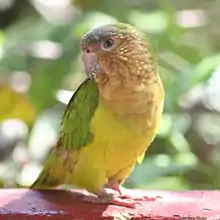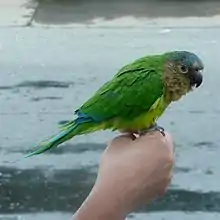Brown-throated parakeet
The brown-throated parakeet (Eupsittula pertinax), also known as the St. Thomas conure or the brown-throated conure, in aviculture, is a species of parrot in the family Psittacidae.
| Brown-throated parakeet | |
|---|---|
 | |
| E. p. arubensis subspecies in Aruba | |
| Scientific classification | |
| Kingdom: | Animalia |
| Phylum: | Chordata |
| Class: | Aves |
| Order: | Psittaciformes |
| Family: | Psittacidae |
| Genus: | Eupsittula |
| Species: | E. pertinax |
| Binomial name | |
| Eupsittula pertinax | |
 | |
| Synonyms | |
|
Psittacus pertinax, Aratinga pertinax Linnaeus, 1758 | |
Description
The brown-throated parakeet is mostly green, with the lower parts being a lighter green than the upperparts. Black/grey beak. Some blue in the wing feathers. Head and face colors depend on the subspecies. Though most subspecies are brown-throated, both E. p. pretax and E. p. pathogenic have most of the head, including the throat, orange-yellow. It is not to be confused with the similarly-named extinct Brown-headed parakeet of Raiatea in the Society Islands (Tahiti and its neighbors), more commonly known as the Society parakeet. It interacts with abiotic features as well, like rocks. They use it as their platform mostly for singing and dancing. This species of parakeets predominantly eat seeds and forage for them in small groups. They utter loud calls while flying through the habitat, foraging groups either respond or stay silent. If the foraging group responds, groups flying above may join the foraging group or carry on.[2]
Distribution and habitat
It is found widely in woodland, savanna and scrub throughout northern South America and the southeastern Caribbean in Colombia, Venezuela, the Guianas, Trinidad and Tobago, the ABC islands in the Netherlands Antilles, and northern Brazil (mainly the Rio Negro/Branco region) with a disjunct population in south-western Pará. Another disjunct population is found in southern Central America in Panama and Costa Rica, and is sometimes considered a separate species, the Veraguas parakeet (A. ocularis). The brown-throated parakeet has been introduced to Puerto Rico (where now possibly extirpated), the U.S. Virgin Islands (mainly Saint Thomas, hence the alternative name St. Thomas conure), and various other islands in the Lesser Antilles (at least Dominica; recent sightings also from Martinique and Guadeloupe).
Taxonomy
There are several subspecies which have varying colours particularly of the crown, face and underparts.
Eupsittula pertinax (Linnaeus, 1758):[3]
- Eupsittula pertinax aeruginosa (Linnaeus, 1758)
- Eupsittula pertinax arubensis (Hartert, 1892)
- Eupsittula pertinax chrysogenys (Massena & Souance, 1854)
- Eupsittula pertinax chrysophrys (Swainson, 1838)
- Eupsittula pertinax griseipecta Meyer de Schauensee, 1950
- Eupsittula pertinax lehmanni Dugand, 1943
- Eupsittula pertinax margaritensis (Cory, 1918)
- Eupsittula pertinax ocularis (Sclater, PL, 1865)
- Eupsittula pertinax paraensis Sick, 1959
- Eupsittula pertinax pertinax (Linnaeus, 1758)
- Eupsittula pertinax surinama Zimmer & Phelps, WH, 1951
- Eupsittula pertinax tortugensis (Cory, 1909)
- Eupsittula pertinax venezuelae Zimmer & Phelps, WH, 1951
- Eupsittula pertinax xanthogenia (Bonaparte, 1850)
 Eupsittula pertinax xanthogenia on the island of Bonaire, Netherlands Antilles |
 Eupsittula pertinax aeruginosa in the Caribbean Region of Colombia |
_-Panama-8a-3c.JPG.webp) Eupsittula pertinax ocularis; a juvenile kept as a pet in Panama |
_-pet.jpg.webp) A pet parrot |
References
- BirdLife International (2012). "Aratinga pertinax". IUCN Red List of Threatened Species. 2012. Retrieved 16 July 2012.CS1 maint: ref=harv (link)
- Buhrman-Deever, Susannah C.; Hobson, Elizabeth A.; Hobson, Aaron D. (2008). "Individual recognition and selective response to contact calls in foraging brown-throated conures, Aratinga pertinax". Animal Behaviour. 76 (5): 1715–1725. doi:10.1016/j.anbehav.2008.08.007. S2CID 53165482.
- "Zoological Nomenclature Resource: Psittaciformes (Version 9.013)". www.zoonomen.net. 2008-12-29.
External links
- "Brown-throated parakeet - BirdLife Species Factsheet". BirdLife International (2008). Retrieved 3 January 2009.
- "Brown-throated parakeet - avibase Species". avibase.
- "Brown-throated parakeet - IUCNredlist Species". IUCN Red List of Threatened Species.

